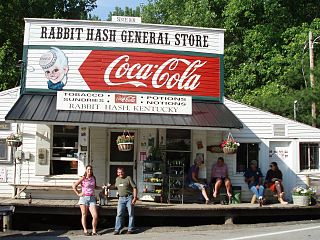Himyar, Kentucky | |
|---|---|
| Coordinates: 36°49′58″N83°47′59″W / 36.83278°N 83.79972°W Coordinates: 36°49′58″N83°47′59″W / 36.83278°N 83.79972°W | |
| Country | United States |
| State | Kentucky |
| County | Knox |
| Elevation | 1,037 ft (316 m) |
| Time zone | UTC-6 (Central (CST)) |
| • Summer (DST) | UTC-5 (CST) |
| GNIS feature ID | 508247 [1] |
Himyar is an unincorporated community and coal town in Knox County, Kentucky, United States.

In law, an unincorporated area is a region of land that is not governed by a local municipal corporation; similarly an unincorporated community is a settlement that is not governed by its own local municipal corporation, but rather is administered as part of larger administrative divisions, such as a township, parish, borough, county, city, canton, state, province or country. Occasionally, municipalities dissolve or disincorporate, which may happen if they become fiscally insolvent, and services become the responsibility of a higher administration. Widespread unincorporated communities and areas are a distinguishing feature of the United States and Canada. In most other countries of the world, there are either no unincorporated areas at all, or these are very rare; typically remote, outlying, sparsely populated or uninhabited areas.
A coal town, also known as a coal camp or patch is typically situated in a remote place and provides residences for a population of miners to reside near a coal mine. A coal town is a type of company town or mining community established by the employer, a mining company, which imports workers to work the mineral find. The 'town founding' process is not limited to coal mining, nor mining, but is generally found where mineral wealth is located in a remote or undeveloped area, which is then opened for exploitation, normally first by having some transportation infrastructure brought into being first. Often, such minerals were the result of logging operations by pushing into a wilderness forest, which clear-cutting operations then allowed geologists and cartographers, to chart and plot the lands, allowing efficient discovery of natural resources and their exploitation.

Knox County is a county located in Appalachia near the southeastern corner of the U.S. state of Kentucky. As of the 2010 census, the population was 31,883. Its county seat is Barbourville. The county is named for General Henry Knox. It is one of the few coal-producing counties in Kentucky that has not suffered massive population loss.
A post office was established in the community in 1906. The town's namesake is the racehorse Himyar, who placed second in the 1878 Kentucky Derby. [2]

Himyar was an American Thoroughbred racehorse and sire. Although successful as a racehorse he is most notable as the sire of 1898 Kentucky Derby winner Plaudit and Domino, the grandsire of Colin and Peter Pan. Himyar lived to be thirty years old, outliving both Domino and his famous grandson Commando, who both died young.
The 1878 Kentucky Derby was the 4th running of the Kentucky Derby. The race took place on May 21, 1878. Winning horse Day Star set a new Kentucky Derby record with a winning time of 2:37.25.





